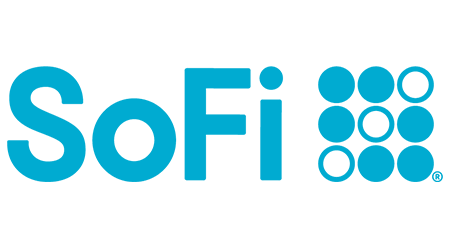
- 0.50% APY on checking balance
- Up to 3.80% APY on savings
- $0 account or overdraft fees
- Get up to a $300 bonus with direct deposits of $5,000 or more
Planning a trip south of the border? Preparing your travel money options beforehand is the key to a stress-free vacation. Credit cards, debit cards, prepaid travel cards and cash are all accepted in Mexico.
Outside of a few purchases like transportation fare or local shops, a credit card will be your best bet for everyday purchases. A card that waives foreign transaction fees like most travel credit cards can help you save on extraneous fees. Here are all of your spending options during your travel.



The local currency in Mexico is the Mexican peso and there are a few ways you spend it. A combination of a travel credit card, travel debit card and a prepaid travel card that allows you to preload the Mexican peso may be your ideal option for your next trip to Mexico. And remember to have some cash too, as it can always come in handy if want to shop at a street market or if a business doesn’t accept credit cards.
ATM’s are widely available in Mexico and are compatible with debit cards, credit cards and prepaid travel cards.
There’s no single best travel money strategy, as the right one will ultimately depend on how and where you’re traveling. If you’re going to be making a lot of cash withdrawals, consider a debit card with an ATM alliance or a prepaid card with low withdrawal fees over a credit card. A credit card will make the most sense for larger purchases and you’ll likely need one for hotels.
You’ll always need cash to make everyday purchases. Withdrawing a substantial amount of cash for when you arrive can be an ideal option to ensure a smooth transition into your destination country.
Whether you’re splurging on tacos, margaritas or are sticking strictly to business, here’s how you can pay for things in Mexico:
Use your credit card almost everywhere, but they aren’t accepted for buses, most taxis, tour guides, corner stores and taquerías. To beat foreign transaction fees, use a card like the Capital One VentureOne Rewards Credit Card (Terms apply, see rates & fees).
Travel cards also often come with a variety of travel perks and the ability to earn rewards. If you pick the right travel card for your travel needs, you can rack up some miles toward your next trip.
Note that chip cards are the standard in Mexico. You can still use a magstripe card at many locations, but you may run into merchants who will only accept chip cards. As such, you may want to upgrade your card before you travel.
| Merchant acceptance | ATM acceptance | |
|---|---|---|
Visa | ||
Mastercard | ||
American Express | ||
Discover |
Explore top debit cards with no foreign transaction fees and travel credit cards by using the tabs to narrow down your options. Select Compare for up to four products to see their benefits side by side.
The Finder Score crunches over 300 checking accounts from hundreds of financial institutions. It takes into account the product's monthly fees, overdraft fees, opening deposit, customer support options, ATM network and features — this gives you a simple score out of 10.
To provide a Score, Finder’s banking experts analyze hundreds of checking accounts against what we consider is the best option: no monthly fees, no overdraft fees, a large ATM network of 50,000 or more, additional features outside of typical banking services, and the optional perk of earning interest. Accounts that are nearly free to maintain and use are scored the highest, while accounts with costly fees and few features are scored the lowest.
The Finder Score is a simple score out of 10. The higher a savings account's score, the better we think it is for the average customer.
We score each credit card in our database of hundreds based on a data-driven methodology with 3 main criteria: Does the card offer rewards? Does the card have an annual fee? What's the card APR%?
Consider cards that have no foreign transaction and ATM fees when looking at cards. Some debit cards, like the one offered by Betterment Checking, are designed for use overseas, so they don’t charge foreign transaction fees on purchases abroad.
Travel cards are generally a good way to take your funds overseas and spend in multiple currencies. Merchants in major tourist destinations like Tijuana, Cancun and Acapulco will accept US dollar as well as pesos preload onto a card.
You can use USD in Mexico, especially in the major tourist spots. Some merchants give you the option of paying in pesos or dollars and the vendor can give you an “over the counter exchange rate” between the two.
The price of the goods can be inflated by as much as 30% if you pay with US dollars in Mexico, as vendors generally use an exchange rate of 10 pesos to $1. Use Mexican pesos to make your money go further.
There are a number of places to exchange cash in Mexico, including Banco de Mexico (the national bank) and at casa de cambios (exchange bureaus). Bank during regular business hours between Monday and Friday.
Your other option is to get money changed at bureaux de change and casa de cambio outlets. These exchange offices are common and they can offer the same rate, if not better, than banks.
Live Rate
Refreshing in: 60s | Sat, Mar 29, 03:50 PM GMT
Mexican Pesos are widely available at most currency exchange offices including Travelex and major banks. Exchanging at your bank can be a good idea to avoid extra fees and charges.
Dating back to Spanish colonization, Mexican pesos come in denominations of 10c, 20c, 50c, $2, $5, $10, $20, $50, $100, $200, $500 and $1000. $20 is the lowest value banknote. MXN is the currency code for Mexican peso and Mexico uses the dollar sign ($) as the currency symbol.
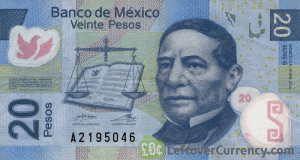 | 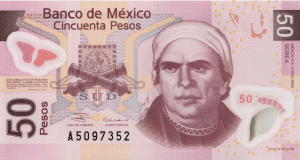 | 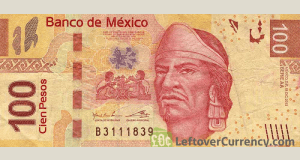 |
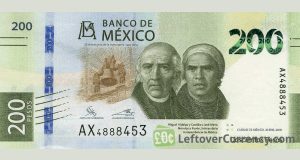 | 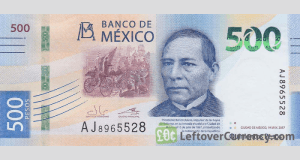 |
You should have no problem finding an ATM for withdrawing cash in Mexico. You’ll find the lowest fees at established national banks like BBVA Bancomer and Santander. And a travel-friendly debit card from a bank like Betterment Checking can help you avoid international ATM charges.
Depending on how much you’ll be traveling around Mexico — and your appetite for expensive cuisine — you could need anywhere from $20 to $150 a day in Mexico — not including accommodations. While it tends to be cheaper than the US, you should still plan on spending about $10 for every meal (at least) and more for activities and transportation.
Here’s a cheat sheet to help while you budget your trip:
| Mexico City | Budget (Cheap) | Midrange | Luxury (High-end) |
|---|---|---|---|
Meals | Lunch in economical restaurant $4–$5 | Dinner with drinks $12–$20 | Fine dinner $20–$40 |
Activities | Museum admission $1–$4 | Uxmal Entrance for two $64 | Personalized day tour $100–$150 |
Accommodation | Hostel dorm bed $10 | Double room $35–$70 | Luxurious hotel double room $70–$600 |
Prices are approximate and are subject to change.
Back to top
How to pay, how much to bring and travel money suggestions for your trip to USA.
How to pay, how much to bring and travel money suggestions for your trip to New Zealand.
How to pay, how much to bring and travel money suggestions for your trip to Thailand.
How to pay, how much to bring and travel money suggestions for your trip to Vietnam.
How to pay, how much to bring and travel money suggestions for your trip to Portugal.
How to pay, how much to bring and travel money suggestions for your trip to Germany.
How to pay, how much to bring and travel money suggestions for your trip to Ecuador.
How to pay, how much to bring and travel money suggestions for your trip to Canada.
How to pay, how much to bring and travel money suggestions for your trip to Japan.
With the rate changing daily , how do I create a quick cheat sheet to use during my one week stay?
Hi Valerie,
Thanks for your question.
I would agree that exchange rates are so volatile, making it hard to predict future changes. If you are preparing a cheat sheet or budget for your future visit to Mexico, there are various ways on how you can lock in rates so you can effectively manage your finances.
One option is by opening a prepaid travel card that allows you to load Mexican pesos before your trip. The exchange rate will be locked in at the time you load currency into your card. You may also consider exchanging your USD for Mexican pesos at most major banks and currency exchange offices prior to your travel. This way, you can pay like the locals do without worrying about fees and charges.
Our guide above also discusses other travel money options for Mexico. It would be good to review the pros and cons of each option so you’ll know which one is suitable for your situation.
I hope this helps.
Cheers,
Anndy